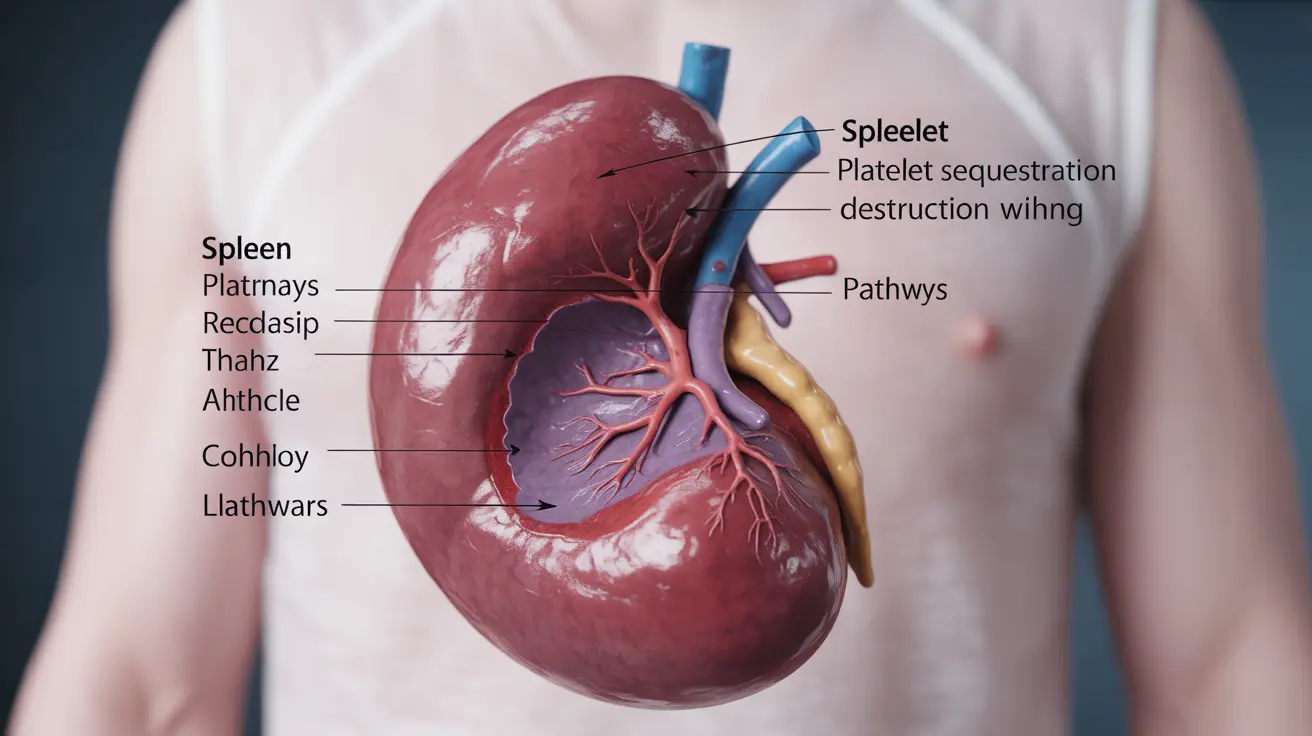When your spleen becomes enlarged, it can significantly impact your blood platelet levels, leading to a potentially serious condition that requires medical attention. This relationship between an enlarged spleen (splenomegaly) and low platelet counts (thrombocytopenia) is important to understand, as it can affect your overall health and treatment options.
This comprehensive guide explores the connection between an enlarged spleen and low platelets, helping you understand the causes, recognize symptoms, and learn about available treatments.
The Connection Between Enlarged Spleen and Low Platelets
An enlarged spleen can directly cause low platelet counts through increased platelet sequestration and destruction. The spleen, which normally helps filter blood and fight infections, can become overactive when enlarged, trapping and destroying more platelets than usual.
This process can result in thrombocytopenia, where platelet counts fall below normal levels, potentially increasing bleeding risks and causing other health complications.
Common Symptoms and Warning Signs
Physical Symptoms of an Enlarged Spleen
An enlarged spleen may cause:
- Pain or fullness in the upper left abdomen
- Feeling full without eating much
- Pain in the left shoulder
- Fatigue and weakness
- Difficulty breathing
Signs of Low Platelet Counts
When platelet counts are low, you might notice:
- Easy bruising
- Prolonged bleeding from minor cuts
- Frequent nosebleeds
- Bleeding gums
- Tiny red spots on the skin (petechiae)
- Heavy menstrual periods
Underlying Conditions and Causes
Several conditions can cause both splenomegaly and low platelets:
- Viral infections
- Blood cancers like leukemia and lymphoma
- Autoimmune disorders
- Portal hypertension
- Liver disease
- Certain medications
Diagnosis and Treatment Options
Medical Evaluation
Diagnosis typically involves:
- Physical examination
- Complete blood count (CBC)
- Imaging studies (ultrasound or CT scan)
- Additional tests to identify underlying causes
Treatment Approaches
Treatment options may include:
- Treating the underlying condition
- Medication to boost platelet production
- Platelet transfusions in severe cases
- Splenectomy (surgical removal of the spleen) in certain cases
- Regular monitoring of platelet counts
Managing Bleeding Risks
To reduce bleeding risks:
- Avoid contact sports and high-impact activities
- Use soft-bristled toothbrushes
- Take precautions when using sharp objects
- Avoid medications that affect blood clotting
- Seek immediate medical attention for unusual bleeding
Frequently Asked Questions
What causes an enlarged spleen to lead to low platelet counts?
An enlarged spleen can trap and destroy more platelets than normal due to increased blood filtering activity and expanded blood storage capacity. This excessive platelet destruction leads to lower platelet counts in circulation.
What are the common symptoms of an enlarged spleen and low platelets I should watch for?
Common symptoms include abdominal pain or fullness in the upper left side, easy bruising, prolonged bleeding from minor cuts, fatigue, and tiny red spots on the skin. You might also experience shoulder pain and feel full quickly when eating.
How is thrombocytopenia related to an overactive or enlarged spleen treated?
Treatment typically focuses on addressing the underlying cause while managing symptoms. Options may include medications, platelet transfusions, and in some cases, surgical removal of the spleen (splenectomy) if other treatments aren't effective.
Can an enlarged spleen increase the risk of bleeding, and how can this be managed?
Yes, an enlarged spleen combined with low platelets increases bleeding risk. Management includes avoiding high-risk activities, using protective equipment when necessary, and following medical advice regarding medications and lifestyle modifications.
What underlying diseases commonly cause both splenomegaly and low platelet counts?
Common underlying conditions include viral infections, blood cancers (leukemia and lymphoma), autoimmune disorders, portal hypertension, and liver diseases. Each condition requires specific treatment approaches to address both the enlarged spleen and low platelet counts.




